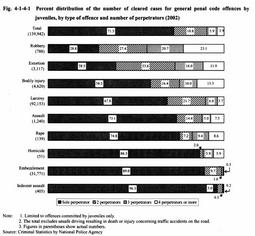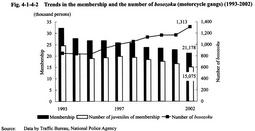| Previous Next Index Image Index Year Selection | |
|
|
1 Group delinquency Fig. 4-1-4-1 shows the percent distribution of the number of cleared cases for general penal code offences by juveniles in 2002 by the number of perpetrators, by type of offense. The percentage of accomplice cases (cases involving 2 or more perpetrators) was highest for robbery (71.2%), followed by extortion (61.5%) and bodily injury (41.7%). For all of them, the percentages are far exceeding those for adults (23.2% for robbery, 38.8% for extortion, and 11.2% for bodily injury).
Fig. 4-1-4-1 Percent distribution of the number of cleared cases for general penal code offences by juveniles, by type of offence and number of perpetrators (2002) A typical juvenile delinquent group is motorcycle gangs, known as bosozoku, which cause disturbances and acts of violence, etc. Fig. 4-1-4-2 shows the trends in the membership and number of bosozoku in the last 10 years. Membership has decreased consistently, numbering 21,178 persons (down 6.7% from the previous year) in 2002. Meanwhile, the number of bosozoku has been on an upward trend since 1996, rising to 1,313 (up 12.5% from the previous year) in 2002. With respect to the size of bosozoku, the percentage of such gangs with 30 or more members fell from 13.7% in 1992 to 3.2% in 2002, indicating that these gangs are becoming smaller in scale (Source: Data by Traffic Bureau, National Police Agency).Fig. 4-1-4-2 Trends in the membership and the number of "bosozoku" (motorcycle gangs) (1993-2002) |

